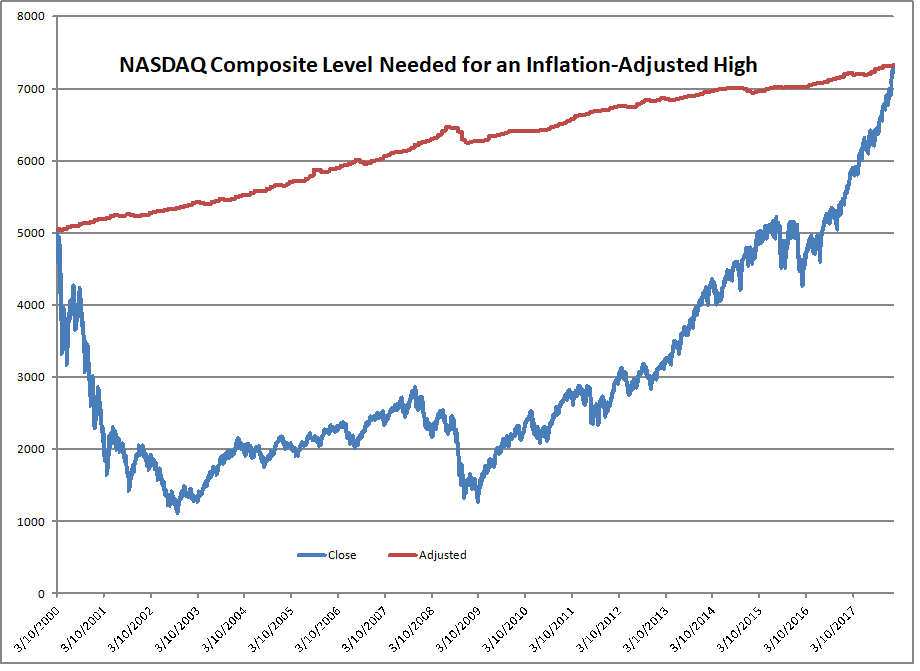NASDAQ Composite Hits an Inflation-Adjusted High

This is an update of a post I did less than three years ago.? In that relatively short time, the NASDAQ Composite hit an all-time record in purchasing power adjusted terms.? Quite an ascent in the last two years.? I never would have predicted it.? If you took the other side of my advice you did better.
That said, the S&P 500 is forecast to return 3.4%/year prior to inflation for the next ten years.? Aside from one quarter during the go-go years (1968), the only period with lower anticipated returns was during the dot-com bubble.? The levels you see today will be revisited going the other way.

The last time I wrote on this, I asked whether it would be better the NASDAQ Composite [IXIC] or Industrias Bachoco [IBA].? IBA is the second largest producer of chicken in North America, and is now expanding in the US.? From the time I wrote the last article it has returned 20%.? NASDAQ Composite? 47%.
That said, I still prefer IBA for the future.? Strong competitive position, little debt.? Intelligent tuck-in style of M&A, showing intelligent capital allocation.? 1.7x book.? 12-13x earnings.? If it weren’t a Mexican firm, it would be valued a lot higher.? IXIC’s valuation metrics are roughly double those.
All that said, IBA beat IXIC over the 12.5 years I have owned it.? 487% vs 401%.? And if you were measuring from the top of the dot-com bubble the return difference is 1460% vs 71%.
IBA still has a lot of room to expand, and is subject to less competition and antitrust threats than many large technology companies.
Not that you should run out and buy IBA (caution: thin market), but what do you do if you are looking for ideas that could be good, but not as much in the spotlight as the companies that make up the bulk of the NASDAQ Composite?? I’ll quote the end of my last article, because the ideas are good, and will likely do better than buying hot ideas now.
…where are the good assets that few are looking at?
Tough question. ?I?ll give you a few ideas, but then you have to work on it yourself.
1)?Look at higher quality names in out-of-favor industries. ?The advantage of this approach is that your downside is likely to be limited, while the upside could be significant. ?I?ve seen it work many times. ?Note: avoid ?buggy whip? industries where the decline is final; the internet is eating a lot of industries.
2) Look at companies outside the US that act in the best interests of outside, passive, minority investors like you and me. ?There is less competition there from analysts and clever US-focused investors. ?Note: spend extra time analyzing how they have used free cash flow in the past. ?Is management rational at allocating capital, or even clever?
3) Look at firms that can?t be taken over, where a control investor seems savvy, and acts in?the best interests of outside, passive, minority investors. ?Many won?t invest in those firms because they are less liquid, and a takeover is very unlikely.
4) Look at smaller firms pursuing a growing niche in an otherwise dull industry. ?Or smaller firms that have good finances, but have some taint that keeps investors from re-examining it.
5) Look through 13F filings for new names that look promising, before too many people learn about the company. ?Or, IPOs and spin-offs in industries that are dull.
6) Analyze stocks that are in the lowest quartile of performance over the last 3-5 years.
7) Or, go to Value Line, and look at the stocks with the highest appreciation potential, with an adequate safety rank.
I use a variety of these ideas.? If I see somethings interesting, I will dig deep and sometimes I get a real gem.? Sometimes not.? But with an adequate margin of safety, I don’t get killed.
Full Disclosure: long IBA




